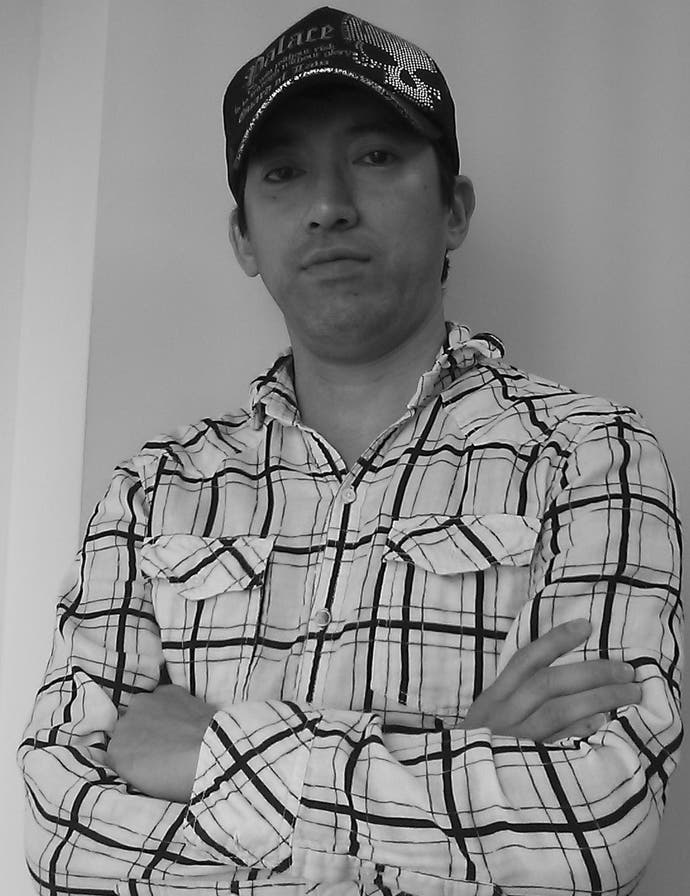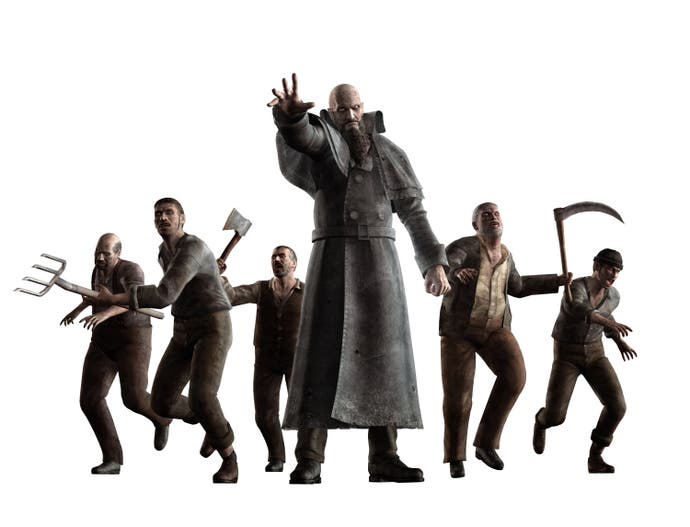Meeting Mikami
From the archive: Japan's master of horror on the evil within and the evil without.
Every Sunday we bring you an article from our archive, either for you to discover again or enjoy for the first time. This week, to celebrate the release of The Evil Within, we present Simon Parkin's profile of its creator Shinji Mikami, first published last July.
Shinji Mikami sits down in a claustrophobic, makeshift room hidden at the very centre of the E3 video game conference floor in Los Angeles. It's a fitting place for the designer, whose work has, one way or another, influenced the majority of the blockbuster video games that flash and growl at the crowds outside the door. These games all carry third or fourth generation strains of Resident Evil 4's DNA. Arguably the designer's greatest creation, its over-the-shoulder viewpoint was subsequently adopted by games as diverse as Gears of War and Batman: Arkham Asylum, while its aiming system, which snaps the camera inwards to focus on enemy targets with a squeeze of the controller's trigger, is now an industry standard. Mikami's inventions, much like the man in this room, sit at the centre of blockbuster video game development today.

How does he feel, walking the show floor, catching familiar glimpses of his ideas reflected in other people's games? "Maybe I influenced them, maybe I didn't," he says. "But I don't really care about all that. I don't think about my influence in the industry. I just make games that I'm interested in." Mikami's nonchalance and swagger is warmer in person than in transcript. He smiles wryly throughout our conversation and, while his answers are often short and pointed, the eyes shine beneath the off-white baseball cap, inviting engagement. At 47 he has worked in video games for close to half his life, having joined Capcom after he graduated from Doshisha University at 25 years old. But all this Los Angeles stuff with the lights, the screens, the action, was never his ambition.
"I didn't play video games as a child," he says. "I wanted to become a Formula One driver, not a game designer." Mikami grew up in the Yamaguchi Prefecture in the Chūgoku region of Honshū island. "It's most famous for the naval base stationed there", he says, referencing the Marine Corps Air Station Iwakuni, which was bombed by American B-29's the day before the atomic bomb dropped on Hiroshima in 1945. Mikami mentions Hiroshima twice in his recollections about growing up, but, perhaps out of sensitivity for the soil on which we meet, the translator neglects to translate what he says.
For Yamaguchi's residents, the memory isn't so easily glossed over. A number of Hiroshima's nuclear victims were brought to the Iwakuni - just 45 minutes away from the damned city - after the bomb dropped, where they died at one of the local army hospitals. Every year residents remember Hiroshima Day. To this day they continue to line the streets with around half a million origami cranes each September to remember the atrocity and to act as a prayer for lasting peace. Mikami grew up amongst the echoes of history's horrors.
"I want to return to survival horror's roots. We've strayed from that. I want to explore fear again, and that sense of overcoming fear, one that's unique to games."

Horror played an important part in Mikami's adolescent years in another sense as he became obsessed with movies such as Texas Chainsaw Massacre and The Evil Dead. "It wasn't just the high you feel from watching something frightening," he explains. "For me, I would obsess over what I might have done differently had I been the protagonist in that situation. I always wanted to do different things. That's why I wanted to make horror video games: to give myself the opportunity to play out my own choices in these extreme, scary situations."
Throughout his teenage years Mikami spent his free time studying karate and kendo. The first video game he played was a wrestling title in the arcades, but his interest in the form was fleeting at most. He studied product and merchandise at university and it was only when he attended a meet-and-greet for promising graduates hosted by Capcom that he considered entering the video game industry.
"In Japan, college graduates are invited to corporate presentations and parties where the company pitches themselves to potential employees" he recalls. "Capcom's presentation appealed to me more than any of the other ones I attended." Initially, however, Mikami's application to Capcom was rejected. "It's mysterious," he says. "During the screening process I was turned down. Then a week later, out of the blue, they called to say I was hired. I have no idea why that happened."
Mikami began his career as a junior game designer and spent his first three months at Capcom working on a quiz game (Capcom Quiz: Hatena? no Daibōken) for the Game Boy. Subsequently, he worked on three licensed Disney titles and an unreleased Formula One game. One of these games, Aladdin, was a sizeable hit, selling in excess of 1.7 million copies and, as a result, his superiors approached him with an offer to direct a sequel to Sweet Home, a popular Famicom game based on a Japanese horror movie.

The resulting title, known as Biohazard in Japan, was a George A. Romero influenced zombie horror game in which you play as a member of a law enforcement task force trapped in a mansion overrun with mutated creatures. The game artfully combined 3D polygonal characters with pre-rendered backgrounds, a graphical decision that made character control cumbersome. This limitation only added to the game's considerable tension. The technique of limiting the player's abilities rather than accentuating them has become a hallmark of Mikami's horror work. Indeed, when showing off a demonstration of his forthcoming title, The Evil Within, we see the protagonist sustain a serious leg injury that hinders his retreat from a pursuing butcher. The sense of encroaching panic while trying to manoeuvre the character around furniture to make an escape is potent, even as an onlooker.
Perhaps this is where other horror game directors go wrong. They make their protagonists formidable. "Used at the right time and in the right way disempowerment can be the most powerful tool for the horror game creator," says Mikami. Is this the reason Mikami, who, apart from a light collaboration on 2011's Shadows of the Damned hasn't made a horror title since 2005's Resident Evil 4, has chosen to return to the genre: because nobody else gets it? "Sequels are a big problem in horror entertainment," he explains. "As a horror game series continues you begin to know who the enemies are going to be. Just this knowledge naturally makes the game less scary. So to capture a wider audience designers add more action. That further reduces how frightening the game feels.
"That's one reason I'm making The Evil Within," he says. "Also, because the graphical quality of games has increased. This has the capacity to make the fear much closer to you. We can add in a far greater amount of animation and make it context based, so, for example, we can change how a character moves in a certain situation." He adds, with a laugh: "Really, I'm making this game just because it's fun to scare people." With The Evil Within, Mikami isn't seeking to reinvent the genre he established and refined. "Instead of trying to introduce new ideas I want to return to survival horror's roots," he says. "We've strayed from that. I want to explore fear again, and that sense of overcoming fear, one that's unique to games."
""Used at the right time and in the right way disempowerment can be the most powerful tool for the horror game creator."

Nobody can begrudge Mikami this return to his design roots. Horror remains a rich seam, largely unexplored in games, not least by Capcom's own, faltering continuation of the Resident Evil series following Mikami's departure from the company in 2007. But I wonder if he feels any frustration at the fact that so much corporate publisher money is spent on refinement rather than invention. The overwhelming focus is on improving a relatively small number of modes of play: the first and third person shooters, gun games.
"I am certainly disappointed that genres are so limited these days," he says. "I want to see a broader spread of games. I love indie games. These younger people with lower budgets and bigger ideas; maybe they will define new genres?" Is this not possible in the blockbuster space then, I wonder? "Big budget games have to sell a great many copies," he says, "which makes new ideas too risky. And sometimes the creator's egos get in the way. I think small games, and personal creations: this is where we'll find the new shoots for the future."
With creative experiments such as God Hand and Vanquish to his name, Mikami cannot be accused of artistic conservatism. Indeed, a creative fidgeting marks his career, even when operating within the inescapable constraints of a sequel. No Japanese game designer can compete on this front. The Evil Within isn't a small game but it is, arguably, a personal creation, a revisiting of the horrors, both fictional and historical, that have influenced his life. As our conversation ends, Mikami leans over the table to generously shake my hand, before opening the door to return to the E3 show floor. Few recognise the face under his cap's faded brim, but the ambient, sub-bass rumble of his influence can be felt all around.









